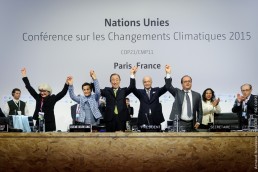China's Next Steps After COP21
Hailed as one of the greatest diplomatic efforts of the past 30 years, 196 countries came to an agreement on December 12th at COP21 in Paris, to take steps to reduce the risk of a global temperature rise beyond 2 degrees. An effort that once again went down to the wire, the agreement represents the start of a long road towards climate change mitigation. It’s a road that many are already calling unrealistic, but for others the agreement itself was a major achievement because it’s the first time that all the major parties, including the United States, were able to reach a consensus.
It’s a framework that has imperfections, particularly because it’s non-binding and void of specific steps that need to, or will, be taken. However, make no mistake, this agreement should be seen as a solid foundation that will lead to action .
For many, the hard work starts now, but for the US and China, this can be seen as a continuation on the work that resulted in the September US-China Joint Statement on Climate Change. It provided a framework that will ensure that developing countries, like China and India, will (re)set the models for how their countries will try to prosper over the next 35 years, whilst developed countries and regions like the US and EU will look more towards how they can clean up their already mature economies.
It’s a framework that in many ways represents what many had hoped would be agreed on in Paris, particularly on areas of emissions commitments, technology transfer, and financing mechanisms.
Going forward though, and in considering the challenges that will be faced as China drives to urbanize another 300 million people by 2030, the agreements made in Paris lay the groundwork for five specific actions:
Reduction in energy intensive industries
As China draws closer to 2030 and the end of its large-scale urban development, which for so long has been the basis of its economy and energy use, its footprint will naturally begin to decrease. With the urban centers well established and growth of its urban population stabilizing, energy intensive industries such as cement, steel, glass, and aluminum will be replaced by a greater contribution of the service economy, and reductions in resources (energy) intensity will be seen throughout the economy.
In fact, natural reductions likely underpin China’s confidence that its emissions will peak in 2030 .
Increased investment in cleaner energy systems
While there have been reports over the last year that China’s coal energy production levels have come down, it’s important to remember that in the short term coal will be China’s primary fuel . Any divestment from coal will come later. In fact, in the last 12 months, over 150 plants have been approved across the country, which will ramp up consumption capacity.
 This doesn’t mean China will forgo the targets set out in its agreement with the US. China now leads the way in renewable investment and nuclear installation, but before King Coal is officially declared dead, changes will come through large scale restructuring of the energy industry, increased investment in renewables, improvements in grid connectivity and production side efficiencies.
This doesn’t mean China will forgo the targets set out in its agreement with the US. China now leads the way in renewable investment and nuclear installation, but before King Coal is officially declared dead, changes will come through large scale restructuring of the energy industry, increased investment in renewables, improvements in grid connectivity and production side efficiencies.
Investments in energy efficiency
This is an area I have addressed in previous blogs. I view this as one of the areas where China has the most potential to see returns and one that is a vital component in the country’s hope of achieving peak emission in 2030.
In fact, in the US-China agreement it was pledged that 50% of new building would be green by 2030. With a large portion of energy consumption coming through energy efficient buildings and cities, the opportunity to mitigate (or even reduce) the energy load required will come through better urban planning, better building standards, and continued retrofitting of existing buildings. This is also likely an area where technology sales/ transfers to China can happen!
 Adjusted resource pricing
Adjusted resource pricing
In the final draft of the agreement there was an emphasis on educating the public on the issue of climate change and sustainable development. Whilst this is a nice sentiment, it’s not going to lead to strong enough behavioral change in the short term.
Within China, we see change coming from the rising cost associated with the consumption of energy. People will not be driven to change unless it directly impacts their daily lives , through convenience or economic and financial implications. Recent announcements by China’s National Development and Reform Commission and the National Energy Administration to move energy pricing to a more market-orientated system support this point. This is a clear signal that the State sees increased cost of energy to residential, commercial and industrial users as a way to change behavior .
Increased transparency leading to effective legal implementation
Whether driven by its own research showing the impact of pollution on its soils, or increased public concern over the impact air pollution has on urban residents, there has been a clear behavioral shift by the Chinese government in recent years .
It started with statements about needing to find a balance, resulted in the promulgation of new laws, forced the closure, fines, and arrest of those in violation of laws, and has also been behind the government’s decision to release PM2.5 data for China’s major cities.
In this area, particularly given that challenges are likely to grow in size and scale as China (and the rest of Asia) urbanize another billion people, it can only be expected that the level of interest (and activity) by the government will increase. At times that interest may not feel sustainable, but none the less it has the power to negatively impact the operations of firms in China.
Conclusions
In reality, while many keeping a watchful eye on COP21 were looking for China (and others) to go above and beyond the call of duty, for China the big commitment was made with the US in September . PM2.5 remains a major problem in China’s cities and is the driving force behind civil concern and energy restructuring, and the actions explained above are seen not just as a way to reduce carbon, but to provide energy to Asia’s billion urban residents without choking its cities.
With much of the above already rumored to be incorporated into the upcoming 5-Year plan, it is clear that whether through the COP process, as part of its drive to reduce PM2.5 emissions, or to feel secure about its energy supplies, China is actively taking steps to identify and address the challenges that its energy system faces . This is a system that is currently adding more power to its grid than all of Europe, every year, and is projected to more than double in size over the next 15 years.
So, while nothing in COP21 is legally binding, I think that in combination with the US-China announcement, China has already begun a process of transacting on commitments to bring emissions under control. It may not be coming out of a sense of moral obligation to the global climate, but perhaps that is why many view China as one of the leaders. Because, beyond the emotions behind the issues, concrete actions are being taken in China every day .

